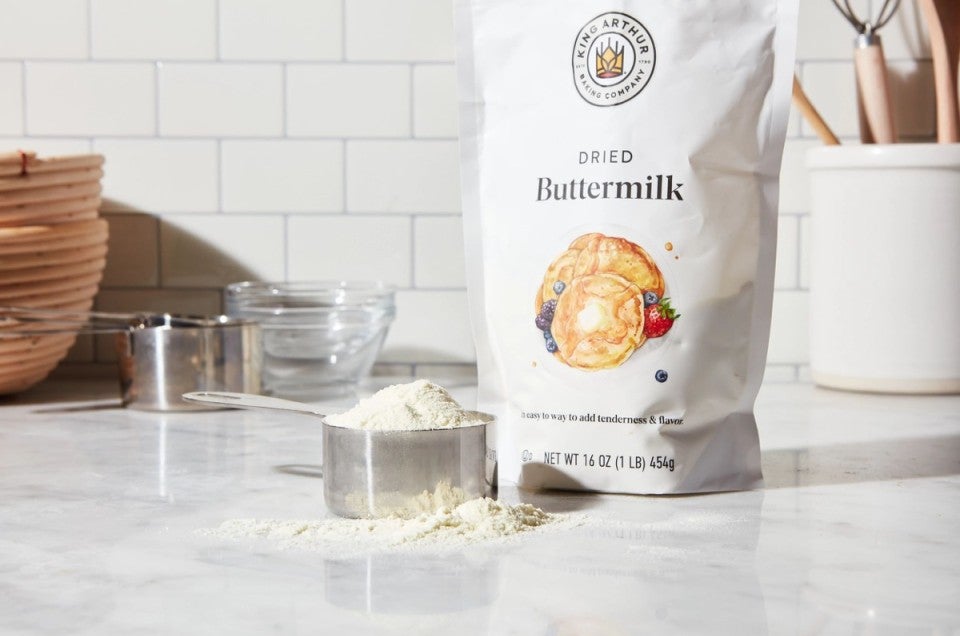Why you should be keeping dried buttermilk in your pantry
Not only is the shelf-stable powder convenient – it’s also great for baking.


Buttermilk is the key to exceptional pancakes, biscuits, and cake. There’s just one problem: Not many of us regularly keep a carton of buttermilk on hand in the fridge. So not only do you have to buy a full carton of buttermilk for the 2/3 cup you need in your biscuit recipe, you then have to search for creative ways to use up the remainder.

The solution: Keep a bag of shelf-stable dried buttermilk in your pantry. No worry; no waste. And no wondering if using yogurt or another similar dairy product is going to give you the same good results.
Dried buttermilk is exactly what it sounds like: fresh buttermilk with its liquid reduced to just around 3%, resulting in a cream-colored, fine-grained powder similar in taste to nonfat dry milk (for which it can be substituted).
Dip your fingertip into dried buttermilk and taste it: Rather than the super-acidic flavor of liquid cultured buttermilk, its flavor is creamy and buttery, with a rich mouthfeel. If you’ve ever made butter out of heavy cream yourself, it tastes exactly like the leftover liquid you’ve separated from the solid butter.
There are two ways you can use dried buttermilk in your baking:
Add dried buttermilk directly to your baked goods. It adds flavor, tenderness, richness, and the positive qualities of milkfats and milk solids: moisture retention and enhanced browning. Try kicking up your favorite pancake, doughnut, or scone recipe with a tablespoon or two of this “secret ingredient.”
Charlotte Rutledge, who led King Arthur’s Test Kitchen for many years, says, “I use buttermilk powder in my pie crust as a dough tenderizer. It helps impede gluten formation and makes the crust easier to roll out (who doesn’t want that?!), and increases the crust’s delicate texture.”

Use dried buttermilk as a substitute for the liquid buttermilk called for in your recipe. It’s simple as (buttermilk) pie: For every cup of liquid buttermilk, substitute 1/4 cup (30g) dried buttermilk plus 1 cup (227g) water (or milk).
Don’t worry about reconstituting the powder by stirring it together with liquid: Simply mix dried buttermilk into your recipe at the same time you add the flour, and add the liquid when the recipe says to add the buttermilk.

I tested substituting dried buttermilk for fresh in four recipes: Buttermilk Pie, Farmhouse Buttermilk Cake, Easy Self-Rising Biscuits, and Old-Fashioned Sugar Cookies. Each call for a different percentage of buttermilk, with the pie being the most buttermilk-intense and the cookies the least reliant on buttermilk.
Here’s what I found: Even in the pie filling, whose main ingredient is buttermilk, substituting dried buttermilk (plus a liquid) for the standard buttermilk in your baking recipe is a raging success.
Dried buttermilk yields results nearly identical to liquid, with just two small differences: Baked goods made with dried buttermilk are slightly lighter in color than those made with liquid cultured buttermilk, and their flavor is a bit richer — more creamy-buttery than tangy.
Another discovery: When replacing fresh buttermilk with dried, using milk in place of the water typically called for in this substitution gives baked goods even better texture and flavor, thanks to the additional milk solids, fats, and sugars.
Bottom line: Dried buttermilk is convenient to use, it's a seamless substitute for fresh buttermilk, and it ends up saving you money in the long run. All solid reasons for making this handy ingredient a mainstay of your pantry.
Speaking of not wanting to make an unexpected trip to the supermarket, check out this article: What to bake if you run out of ingredients.
Cover photo by Rick Holbrook; food styling by Kaitlin Wayne.


